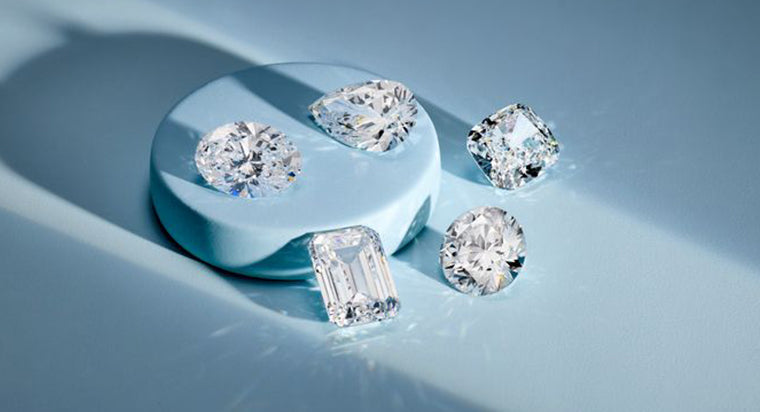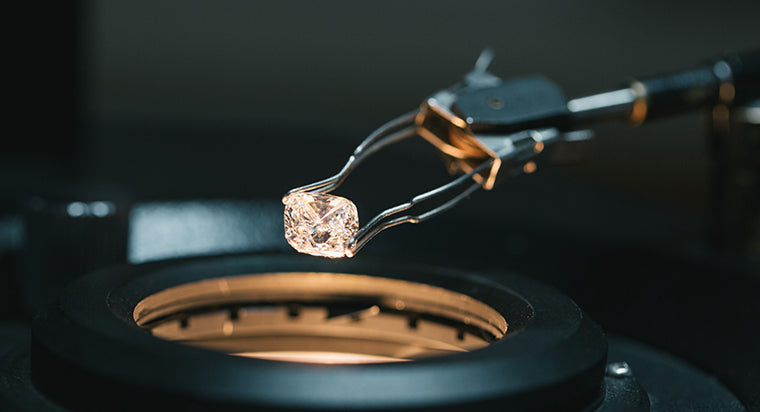SI2 vs SI1: How Different Are These Clarity Grades?

Learning all the lingo that goes along with shopping for a diamond engagement ring can seem like learning a foreign language. There are so many different clarity grades — ranging from FL to I1 — that it's difficult to know what to look for (and what to stay away from).
Diamond clarity grades can be a bit controversial, too — especially when you go down the scale. One of the most debated grades? SI, or slightly included diamonds. Let's break down the differences between the SI2 vs. SI1 clarity grades to help you figure out if it's the right pick for diamond engagement ring.
TABLE OF CONTENTS
SI2 vs SI1: What's the Difference?
Both SI2 and SI1 clarity diamonds have inclusions that you might be able to see with the naked eye — some big, some small — and can be seen on the center or sides of the stone near the girdle. The biggest differences in the SI2 vs SI1 debate are the number and type of inclusions they have.

SI1 diamonds tend to have fewer inclusions than SI2 — as few as one inclusion, to several in the same stone. The inclusions tend to be smaller and can range from crystals to feathers, knots, needles, cavities, chips, clouds, twinning wisps or indented naturals. (Wondering what the heck all those terms mean? Check out our guide to diamond inclusions to find out more and see examples of these types for yourself.)
SI2 diamonds, on the other hand, will have the same types of inclusions as SI1 diamonds, just more of them. They tend to be larger, too.

As for their looks? Well, that depends on the actual stone. As you can see, there isn't always a huge difference in appearance when it comes to SI2 vs SI1 diamonds. One might appear foggier or have a less-than-perfect appearance when compared to the other, but the typical ring admirer probably won't be able to tell the difference in the shine between the two.
SI2 vs SI1: How Their Prices Stack Up
The biggest upside to an SI diamond is the price. SI1 diamonds are just a grade below a Very Slightly Included 2 diamond, meaning they're very similar — but with very different prices. Typically, an SI diamond will save you anywhere from 10 to 20 percent over a VS diamond.
You will also see a price difference when you compare an SI2 vs SI1 diamond, but the actual difference depends on the actual stone itself.
Are SI Diamonds a Good Choice? The Bottom Line
Simply put, SI clarity diamonds should be evaluated on a case by case basis for your diamond engagement ring. We've seen some gorgeous SI diamonds before. But we've also seen, and advised customers against buying, some SI diamonds that definitely weren't ideal for brilliance.
If you want to invest in SI diamond, it's best to work with a gemologist who can help you find the best stone with the fewest inclusions. An expert gemologist can also help you pick a diamond engagement ring setting that'll help mask any inclusions that take away from the beauty of your stone.
Still interested in an SI diamond but don't know where to start? Fill out the short form below and we'll have our experts hunt down three personalized diamond suggestions that fit your tastes and budget. Like one? Wonderful! We can chat from there. None of them fit? Tell us. Our experts want you to be happy, and they'll go back to the drawing board to hunt down that perfect fit.
FAQs
Is SI2 a good diamond?
An SI2 diamond can be a good purchase if it is eye-clean. SI2 clarity diamonds have noticeable inclusions that a diamond grader can see using 10x magnification. Sometimes, the inclusions like feathers, chips, and clouds are so many and so big that they can be seen with the naked eye too.
However, there are selected SI2 stones that work beautifully for some people and can translate into big savings. Thus, it is best to work with a gemologist who can help you find the best stone with the fewest inclusions.
What is the best shape to cover SI2 inclusions?
The best shape to cover SI2 inclusions will depend on the location and size of the inclusions. However, generally speaking, a round or cushion cut diamond will have a larger surface area and can potentially cover inclusions more effectively than a more elongated shape such as a marquise or pear cut. It's always recommended to examine the diamond physically or through high resolution images to make an informed decision.
What are the common inclusions in a SI2 diamond?
Some of the most common inclusions seen in a SI2 diamond include crystals, feathers, knots, needles, cavities, chips, clouds and twinning wisps.
Is SI1 a good diamond?
SI1 is a clarity grade for diamonds, with "SI" standing for "slightly included" and "1" indicating that the inclusions, or internal flaws, are visible under 10x magnification. SI1 diamonds can have inclusions that are visible to the naked eye, but they are usually small and do not significantly affect the diamond's overall appearance. SI1 diamonds are generally less expensive than higher clarity grades, such as VVS or Flawless, but they can still be very beautiful and a good value. Ultimately, whether a diamond is "good" or not depends on the individual's personal preference and budget.
What are the common inclusions in an SI1 diamond?
The inclusions found in SI1 diamonds can vary depending on the diamond, but they are typically small and do not significantly affect the diamond's overall appearance. Some common inclusions found in SI1 diamonds include:
- Crystals: Tiny mineral crystals that are trapped inside the diamond during its formation. They can appear as small dots, lines or clouds and can be of various colors.
- Feathers: Small fractures or breaks in the diamond's crystal structure that can appear as thin, wispy lines.
- Knots: Small crystals that have grown up against the surface of the diamond and are visible from the front.
- Pinpoints: Tiny dots that can appear singly or in clusters and can be of various colors.
- Bearding: A type of inclusion that appears as a thin, curved line.
- Needles: These inclusions are thin, elongated crystals that have grown in the diamond.








